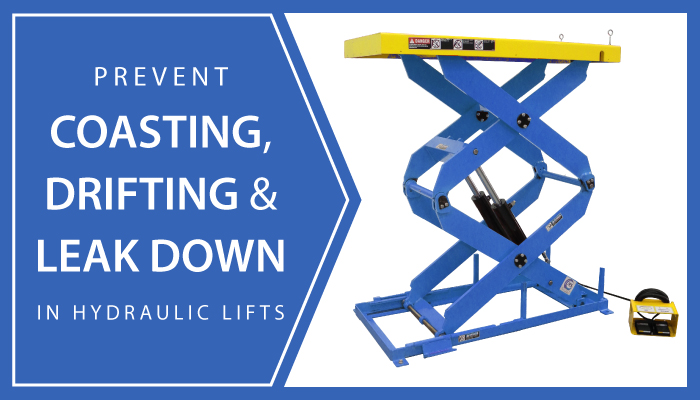We use cookies to make your experience better. To comply with the new e-Privacy directive, we need to ask for your consent to set the cookies. Learn more.
How to Prevent Coasting, Drifting, and Leak Down in Hydraulic Lifts
If you work with hydraulic lift tables, you've probably encountered a frustrating scenario: You get the lift at the precise elevation you need for a job, and then the darn thing scoots upwards just enough to cause a problem. Either that or it dips down when you add a load.
These are unwanted side-effects of the hydraulic technology that powers industrial lifts. But with a little smart engineering, coasting and leak down can be reduced to near-zero rates.
Understanding Coasting, Drifting, and Leak Down

Coasting is fairly common for lower-quality lift tables, but it can be a real headache for applications that require precise elevations, like multi-level conveyor lines. It occurs when the table’s momentum drives it upwards even after users disengage the limit switch.
The American National Standards Institute (ANSI) sets limits for lift table drift at 3/4" per hour with 36" of travel. But for some applications, even this standard isn't stringent enough. To totally eliminate coasting and drift, you need hydraulic systems that are built for precision.
Engineering a Solution for Imprecise Elevation in Lift Tables
Once a lift table is installed, it's usually too late to build protections against over- and under-travel into the machinery. When you’re planning equipment purchases, ask for a no-coast manifold system from BHS.
This package adds a series of check valves into hydraulic cylinders. These valves are incorporated into the integral manifold along with the up and down solenoids, checking the load instantaneously when a user releases the foot pedals.
Most drifting is caused by leakage in hydraulic cylinders. Lift Tables from BHS prevent this problem in the simplest way possible: by using only the highest-quality hydraulic components on the market. Lines are braided with heavy-duty wire for durability, while hardened chrome piston rods create a superior seal. Purpose-built hydraulic cylinders are expertly honed to prevent leaking.
To protect against more catastrophic elevation loss, every BHS hydraulic system includes thermal overload protection and a velocity fuse that instantly locks lines in the unlikely event of a rupture.
Every Lift Table that BHS ships has been extensively tested by the time it reaches the customer. Technicians inspect each component above the specified load limit to insure reliable performance for the entire working life of the equipment. When you need exact elevations from a Lift Table, every time, BHS delivers.
References:
Casey, Brendan. "The Root Cause of Hydraulic Cylinder Drift." Machinerylubrication. Noria Corporation, Nov. 2007. Web. 7 May 2016.
"Hydraulic Cylinder Drift's Impact on Control and Safety." Liftandaccess. Heartland Construction Division, 28 June, 2013. Web. 7 May 2016.
"Two Simple Solutions to Prevent Hydraulic Cylinder Drift." Aggressivehydraulics. Aggressive Hydraulics, Inc., 27 Aug. 2015. Web. 7 May 2016.
